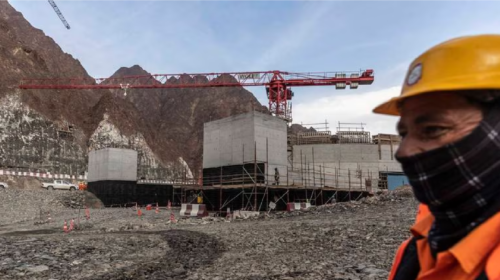The flow of water will soon help power businesses and homes in the UAE with clean energy. A huge hydroelectric power plant is under construction in the rugged Hajar Mountains, outside Dubai, that will utilise the turquoise waters of Hatta Dam.
The station is planned for completion towards the end of 2024 and will have a production capacity of 250 megawatts. One megawatt can typically power 500 to 1,000 homes for a year. It will have a storage capacity of 1,500 megawatt hours and a lifespan of up to 80 years.
About 1,400 people were working at the site when The National visited to see progress. Cranes surrounded the powerhouse containing the turbines, while heavy machinery and vehicles were being used for backfilling the area.
The excavation of the 1.2km water tunnel connecting the upper dam with the lower reservoir is complete, and its steel and concrete lining is nearly ready. Work is also under way on the reinforced concrete for the powerhouse, which is 85 per cent finished.
“Construction began in 2019 and about 60 per cent of the project is now complete,” said Khalifa Albedwawi, project manager of the Hatta hydroelectric power plant, as he gave a tour of the development wearing a safety vest and helmet. The plant is the first of its kind in the GCC because it can store energy, he added.
The plant, being built by Dubai Electricity and Water Authority (Dewa), can operate in two modes: turbine and pumping. When there’s demand for electricity, the equipment will work in turbine mode. The water stored in the upper dam will flow through the tunnel and rotate turbines. The mechanical energy will then be converted into electrical energy and sent to the power grid.
The plant’s response time to heightened demand for energy is 90 seconds. During off-peak hours, the water is pumped back to the upper dam, making the project 100 per cent renewable. “During the pumping mode, the plant will utilise the clean energy coming from the Mohammed bin Rashid [Al Maktoum] Solar Park to feed these turbines, to work as a pump,” Mr Albedwawi said.
“It will take part of the existing water in Hatta Dam through the water tunnel to the upper reservoir. It will be stored as potential energy with a height difference of 150 metres.” A cofferdam enclosure has been built to keep Hatta Dam’s water away from the construction site.
The powerhouse is part of the existing Hatta Dam. To build this powerhouse, we had to build a cofferdam, in order to keep this area isolated from the Hatta Dam and to protect it from floods.”
Mr Albedwawi drove from the lower reservoir to the upper dam via a winding mountain road in about 15 minutes. He passed through two access tunnels, each 500 metres long, to enter the construction site. Once the power station is operational, the tunnels will be used by staff operating the plant.
“The upper dam has two walls. The height of the main wall is 72 metres and the side wall is about 37 metres. They are made of Roller Compacted Concrete and both walls are complete,” Mr Albedwawi said.
The plant will help achieve the Dubai Clean Energy Strategy 2050 and the Dubai Net Zero Carbon Emissions Strategy 2050 to provide 100 per cent of the emirate’s total power production capacity from clean energy sources.
“The project supports the plan to meet the social, economic development and environment needs in addition to providing job opportunities for UAE citizens in Hatta,” Mr Albedwawi added.





